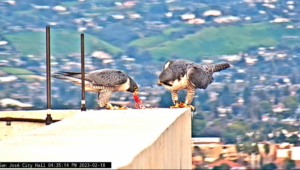When California condor number 307 saw biologists capturing other condors at Pinnacles National Monument last summer, she apparently spooked and flew northeast to San Luis Reservoir. By the time she returned three days later, biologists were concerned: Of the ten juvenile condors they had captured three days before, four were found to have lead in their bloodstreams. When 307 was at last captured, field tests revealed lead levels that would require a medical response in humans, says Pinnacles park ranger Carl Brenner. The scientists immediately injected the bird with a treatment designed to accumulate the lead and pass it out of the bird’s body.
“Lead poisoning from ammunition is the single greatest obstacle to the recovery of wild California condors,”says Jeff Miller of the Center for Biological Diversity, part of a coalition that filed suit in November 2006 against the California Fish and Game Commission for continuing to allow the use of lead ammunition by hunters in condor territory. A recent study published in Environmental Science and Technology concluded that lead-based ammunition in abandoned carcasses is the principal source of elevated lead exposure in the endangered birds.
Listed under the federal Endangered Species Act in 1967, condors were on the brink of extinction in 1987 when the last wild condor was captured for a captive breeding program. In 1997, the Salinas-based Ventana Wildlife Society began releasing juvenile condors in Big Sur; the program was expanded to Pinnacles National Monument in 2003.
Thanks to these and other efforts, the California condor population is slowly recovering. As of August 2006 there were 289 condors, with 138 in the wild. Forty-one of these wild condors, with their nine-foot wingspans, soar on thermals over Big Sur and Pinnacles National Monument. Some of the birds are just now reaching reproductive age, which is why biologists are so worried about lead poisoning. The success of the release program depends on these birds’ ability to live to reproductive age (about six years) and then reproduce in the wild.
To learn more about the California condor and the work of Ventana Wildlife Society, visit the Oakland Museum to see “Bringing the Condors Home,” a collaborative exhibit that opened in December and runs through April 15, 2007. The exhibit traces the precipitous decline and recent tenuous recovery of the condor, and includes a six-foot-tall walk-in panorama of the release site in Big Sur.
See www.museumca.org for more information. To track the progress of the condors in the wild, check out the monthly field notes at www.ventanaws.org.

.jpg)



-300x226.jpg)